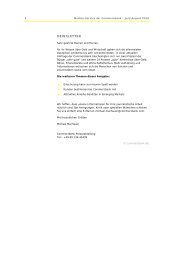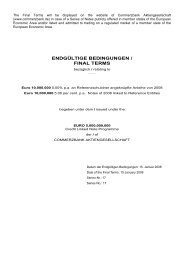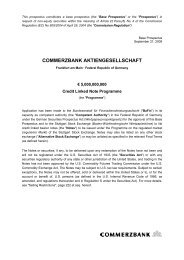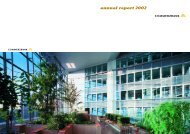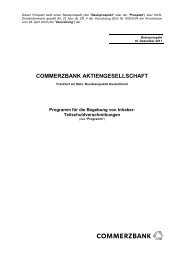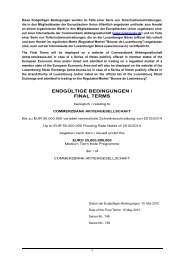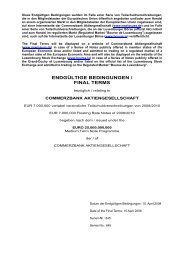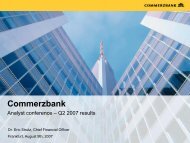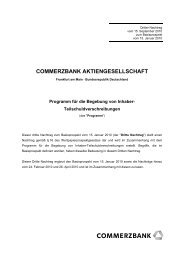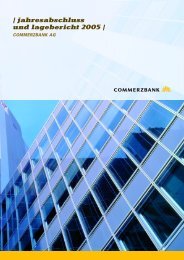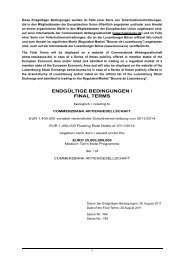COMMERZBANK AKTIENGESELLSCHAFT
COMMERZBANK AKTIENGESELLSCHAFT
COMMERZBANK AKTIENGESELLSCHAFT
Create successful ePaper yourself
Turn your PDF publications into a flip-book with our unique Google optimized e-Paper software.
To our Shareholders Corporate Responsibility Management Report Risk Report Group Financial Statements Further Information 217 273<br />
258 202 Statement of comprehensive income<br />
260 204 Balance sheet<br />
262 206 Statement of changes in equity<br />
264 208 Cash flow statement<br />
266 210 Notes<br />
409 353 Auditors’ report<br />
b) Classification of financial assets and liabilities and their<br />
measurement<br />
Below we set out an overview of the categories defined in<br />
IAS 39. These are: loans and receivables, held-to-maturity<br />
financial assets, financial assets or liabilities at fair value<br />
through profit or loss, available-for-sale financial assets and<br />
other financial liabilities.<br />
• Loans and receivables:<br />
Non-derivative financial instruments with fixed or<br />
determinable payments that are not quoted in an active<br />
market are assigned to this category. This holds true<br />
regardless of whether they were originated by the Bank or<br />
acquired in the secondary market. An active market exists if<br />
quoted prices are readily and regularly available from an<br />
exchange, dealer, broker, industry group, pricing service or<br />
regulatory agency and those prices represent actual and<br />
regularly occurring market transactions on an arm’s length<br />
basis. Measurement of these assets is at amortised cost. If<br />
there is impairment, this is recognised in profit or loss when<br />
determining the amortised cost. Premiums and discounts are<br />
recognised in net interest income over the life of the asset.<br />
In the case of reclassified securities contained in the loans<br />
and receivables category the fair value at the date of<br />
reclassification is taken as the new carrying amount. The<br />
revaluation reserve net of deferred taxes existing at this point<br />
remains in the other reserves within equity and is amortised<br />
over the remaining term of the reclassified securities.<br />
For financial assets classified as loans and receivables<br />
impairments are recognised in the same way as for lending<br />
business (see Note 9). Impairment of these financial<br />
instruments is included in net investment income and<br />
deducted directly from the financial investments. If the<br />
indicators for impairment of particular securities cease to apply<br />
or no longer suggest an impairment, the impairment of the<br />
securities must be reversed through profit or loss, but to no<br />
more than the level of amortised cost. Similarly, an improved<br />
risk environment can lead to the reversal of an impairment that<br />
was previously recognised at the portfolio level.<br />
• Held-to-maturity financial assets<br />
Non-derivative financial assets with fixed or determinable<br />
payments and fixed maturity may be included in this<br />
category if the entity has the positive intention and ability to<br />
hold them to maturity. Measurement of these assets is at<br />
amortised cost. If there is impairment, this is recognised in<br />
profit or loss when determining the amortised cost.<br />
Premiums and discounts are recognised in net interest<br />
income over the life of the asset. In the 2011 financial year<br />
Commerzbank Group again made no use of the held-tomaturity<br />
financial assets category.<br />
• Financial assets or financial liabilities at fair value through<br />
profit or loss; this category comprises two sub-categories:<br />
– Financial assets or liabilities held for trading:<br />
This sub-category includes financial assets and financial<br />
liabilities held for trading purposes (trading assets and<br />
trading liabilities).<br />
Derivative financial instruments used for hedging<br />
purposes are only reported under trading assets or trading<br />
liabilities if they do not meet the conditions for the<br />
application of hedge accounting (see below in this note).<br />
Otherwise, they are shown as fair values from derivative<br />
hedging instruments.<br />
Trading assets and trading liabilities are measured at<br />
their fair value on each balance sheet date.<br />
If the fair value cannot be established on an active<br />
market, items are measured by means of comparable<br />
prices, indicative prices of pricing service providers or<br />
other banks (lead managers) or internal valuation models<br />
(net present value or option pricing models). Interest-rate<br />
and interest-rate currency derivatives are measured in<br />
accordance with standard market practice taking account<br />
of the respective fixing frequency for variable payments.<br />
In the case of derivative positions costs may be incurred<br />
in closing positions in the event of counterparty default if<br />
a positive market value remains after offsetting and<br />
collateral agreements have been taken into account.<br />
Group Financial Statements



